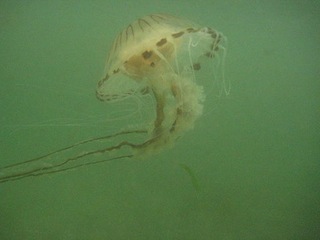 It’s easy to see how the Compass Jellyfish gets its name.
It’s easy to see how the Compass Jellyfish gets its name.
Photo: Ray Surridge
Scientific name: Chrysaora hysoscella
Other common names: Sea Nettle
Cornish name: morgowlesen is the general word for a jellyfish
What to look for:
- Colouring and appearance: Easily identifiable by the 16 long v-shaped brown markings on the upper surface of the pale-coloured bell. There are 24 thin tentacles, arranged in eight groups of three, and four thicker frilled arms.
- Size: The bell is up to 30 cm in diameter.
- Where: Around the British coastline, but particularly numerous in the west.
 This common jellyfish of our coastal waters gets its name from the brown markings on its bell, radiating from a dark spot at the centre, just like a compass. On a boat trip you might spot one just below the surface, eerily pale, its bell pulsating, its long tentacles trailing behind through the water. Those long tentacles are used to catch its planktonic prey, which is then passed on to the arms grouped around the mouth on the underside of the bell.
This common jellyfish of our coastal waters gets its name from the brown markings on its bell, radiating from a dark spot at the centre, just like a compass. On a boat trip you might spot one just below the surface, eerily pale, its bell pulsating, its long tentacles trailing behind through the water. Those long tentacles are used to catch its planktonic prey, which is then passed on to the arms grouped around the mouth on the underside of the bell.

A mature Compass Jellyfish is a hermaphrodite, starting life as a male and then becoming a female. The reproductive cycle is fascinating, using both sexual and asexual reproduction at different stages. Firstly, a jellyfish functioning as a male releases sperm through its mouth which is taken in through the mouth of a functional female, followed by fertilization (sexual reproduction). The female releases tiny larvae in summer and autumn which, after a few days, become fixed (sessile) to a surface as a polyp (a trunk surrounded by tentacles), called a scyphistoma. This then produces minute jellyfish the following spring (asexual reproduction), which grow into the familiar mature jellyfish by the summer.
The Compass Jellyfish can sting humans, but this usually only results in mild discomfort.
Did you know…?
…Jellyfish move through the sea by pulsating their bell.
…The Compass Jellyfish mouth, found at the centre of the underside of the bell, is its only external orifice.
More information and references:
Turk, S.M., 1971. Seashore Life in Cornwall and the Isles of Scilly. D. Bradford Barton Ltd., Truro.
Published: July 2015
Author: Amanda Scott
Photos: Upper, Ray Surridge; lower, Joebater (Engelska Wikipedia) CC-BY-SA-3.0
